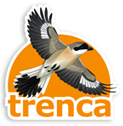
25 days old chick of Lesser Kestrel. © Trenca
A total of 12 pairs form the colony settled in the roof of the farm storage building that Trenca restored this spring. This is one of the most important colonies of Lesser Kestrel (Falco naumanni) in Catalonia.
During this month of July, technicians from the Agriculture Department (DAAM) banded the Lesser Kestrel chicks that were born this season in the new roof of the farm storage building from Alguaire (Lleida), specially designed to favor the breeding of the species. There were 12 nesting pairs, one of which was not successful at breeding. The other 11 had their eggs hatched and raised their chicks. 28 chicks were banded, which means an average of 2 -3 chicks for every breeding pair.
Eggs are laid in May. Chicks are banded when they are approximately 25 days old (just about to fly). As egs are not laid at the same day, to band band the chicks from the colony when they are this age different banding days are needed, usually between the last days of June and the thrid week of July, depending on the season and the characteristics of the colony.

While banding the chicks (placing a band on his leg that will allow us to identify him individually). © Trenca

While banding the chicks (weighing a Lesser Kestrel chick). © Trenca
The restoration of this roof was included in the objectives of the land stewardship agreement that Trenca signed last October with the farm owner, located in the municipality of Alguaire (El Segrià regional district, Lleida). The lesser kestrel is a migratory species that arrives in Europe in Spring, and makes a long journey back to Africa in Autumn. The restoration works were carried out thanks to the collaboration of ENDESA this last spring, before the first lesser kestrels arrived.

One of the restored sides of the roof, with tiles specially designed to favor the breeding of the species. © Trenca

Apppearence of the farm storage building. © Trenca
Land stewardship is a strategy of the civil society for the conservation of natural, cultural and landscape values. Through a stewardship agreement a voluntary pact is done between a land stewardship entity and a land owner, in order to maintain or recover the natural or cultural heritage of the farms under the agreement.
This action has had the collaboration of:




